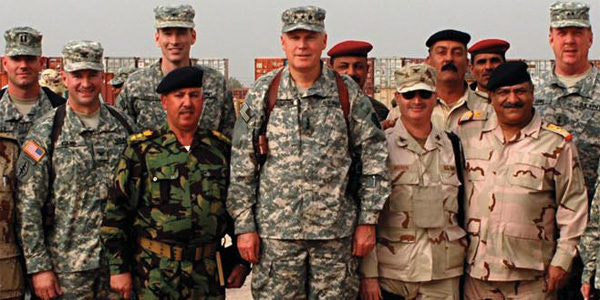doing what's right: interview with Vice Admiral Al Thompson

Perhaps the best way to convey the scale of the operation Vice Admiral Alan Thompson oversees is to put it this way: If it were a company in the private sector, it would rank 57th in the Fortune 500.
The operation in question is the Defense Logistics Agency (DLA)—a logistics combat support agency that provides virtually everything America's military forces eat, wear, drive, shoot, or burn as fuel. The DLA operates like a business, selling goods and services to the military (with a congressional mandate to break even). In fiscal 2008, it reported more than $42 billion in sales.
As you might expect, it's an organization with a lot of moving parts. According to the DLA's Web site, the agency has 23,000 military and civilian employees, operates 25 distribution depots, and manages the flow of 6.4 million items across eight supply chains.
But ask Vice Adm. Thompson, who serves as the DLA's director, about his agency's complex responsibilities and he doesn't cite statistics. Instead, he boils its mission down to this simple goal: "Doing what's right for the armed forces and the Department of Defense."
The vice admiral came to his current assignment in November 2008 after more than 30 years in the military. He received his commission in 1976, after graduating from the University of California, Los Angeles, where he had participated in the Navy ROTC program. In the years that followed, he served in a variety of positions in the Navy and earned a number of awards, including the Distinguished Service Medal. Since he achieved flag rank, his assignments have included duty as commander of the DLA's Defense Supply Center in Columbus, Ohio; director of the supply, ordnance, and logistics operations division (N41), Office of the Chief of Naval Operations; and as commander, Naval supply systems command and chief of supply corps. He met recently with DC VELOCITY Editor at Large Steve Geary to talk about the agency's current activities as well as its future.
Q: Many of our readers are unfamiliar with the DLA, so let's begin there. Would it be fair to describe you as sort of a Wal-Mart Super Center for the military?
A: I did a tour as the center commander in Columbus [DLA's Defense Supply Center in Columbus, Ohio], and I remember being asked, "Well, aren't you just Wal-Mart?" The reality is, that might describe a thin slice of what DLA does, but DLA is a full-spectrum logistics service provider and so, its activities are a lot broader.
Q: Can you provide an example of how the DLA does more than simply serve as a mega-supply center?
A: A little story from Iraq: We visited the Taji national maintenance staff in the region north of Baghdad. It essentially is the sole depot [for maintaining, repairing, and overhauling ground vehicles] that the Iraqi army has for ground combat. We have a DLA team there that is assisting the Iraqi army in bringing its maintenance activity on line.
What they are primarily focused on right now is overhauling Humvees that came from U.S. stocks, and they are doing a full overhaul. DLA's role has a couple of dimensions. One is providing much of the material support to do the depot maintenance work. The other is helping them establish a distribution center capability so that they [the Iraqi army] can in fact bring their own supply system up on line.
It is just overwhelming the enthusiasm these guys have for what they're doing. They have actually only been there about six months, but you can tell what a huge impact they've had in that time in helping the Iraqi security forces essentially develop their own sustainment capability. As you travel around, it is quite striking how engaged we are now at the forward end of the supply chain, largely providing the types of commodities that DLA is responsible for, but in some ways, also helping with technical expertise to bring on line some of their own DLA-like capabilities.
Q: DLA started out as a wholesale provider of items required by the military. What you are describing seems to be more of a customer-facing, demand-driven organization.
A: Being focused and having a forward presence is an important part of where DLA is going in the future— particularly in the Middle East. We need to have a very robust physical presence of DLA personnel where our major customers are. We have DLA support teams that are embedded with our major customers, and in effect, they are a forward touch point to removing barriers that may exist in the integrated supply chain. We now have pretty robust staffing forward that covers the full spectrum of DLA support, and frankly, we have gotten very positive reviews from that.
Q: Can you provide some examples of how that plays out in practice?
A: We're putting a lot of the emphasis right now on logistics support for the arriving forces in Afghanistan. As you know, it is a very austere area from the standpoint of infrastructure. A lot of effort right now is just moving what is needed in place to build the operating bases. It is everything from lodging to you-name-it.
Of course, most everything there has to be taken in on a truck over a 500-plus mile dirt road through mountains. As it comes up from Karachi in Pakistan through a couple of points of entry into Afghanistan, there have been considerable concerns with not only volume of flow but also with security of those routes, so we are working very intensively with U.S. Central Command and U.S. Transportation Command to open what is called the Northern Distribution Network—lines of communication or supply from the north through the Central Asian states. It is a very complex issue with lots of host-nation dimensions from the standpoint of flow of material, but we have been very successful moving it all forward.
I think that our forward presence and close connection to the combatant commanders has been a huge enabler for their mission effectiveness. Whether you look at DLA people deployed in Afghanistan or Iraq or back home at some of our major field commands, there is very tight connectivity. The more of that we have, the more effective we are going to be.
Q: Can you talk a little bit about crossover between commercial best practices and DLA's operations?
A: DLA is a huge global enterprise, but our top priority is effectiveness. Having said that, another very important responsibility is stewardship of the taxpayer's dollar. We are true believers that we need to be on a never-ending quest to be as efficient as we can possibly be because the taxpayers shouldn't pay a penny more for the product that we provide than is absolutely necessary.
In my Director's Guidance for 2009 [a document similar to a corporation's strategic plan], we established four strategic focus areas: warfighter support, work-force development, stewardship improvements, and business process enhancements. The top one, of course, is warfighter support enhancements, which is really about effectiveness. The work-force development area is focused on retaining and recruiting the work force of the future and doing the necessary core development work to be as relevant to America's armed forces in the future as we are today. Stewardship improvements and business process enhancements are related to continuously improving the business at DLA. There is a lot of crossover to industry best practices when you look at our supply chain management and distribution roles.
Q: Can you expand on how you have approached the challenge of adopting commercial best practices?
A: A critical enabler to importing commercial best practices into DLA has been our information technology investments over the last decade. We have our enterprise business system that began as an ERP implementation but now is broader. We are continuing to build on that with a couple of big additions. There is a module called e-procurement, where we are in effect the Defense Department's leader in bringing this contracting capability into the DOD in place of a legacy system that was government-unique. We are also expanding the enterprise business system to cover the energy segment, replacing a lot of different legacy systems.
There are also other things that have occurred over the last few years: the focus on performance-based contracts and prime vendor arrangements, particularly in the area of troop support. But we also have several now in the hardware area, which allows us to manage suppliers instead of supplies. We are always looking for opportunities to rapidly import commercial best practices, recognizing that when the day is over, we are about effectiveness and we have to get the balance right between effectiveness and efficiency.
Q: Is there anything we haven't talked about yet that you might like to add?
A: Just being back in the agency for a few months, I am struck by several things. We have a world-class human capital organization, very well postured to refresh our work force over the next decade. We will see increasing attrition over the next 10 to 15 years, but I feel very comfortable that we've got all the right programs in place to replenish the DLA work force in the future with one that is even more capable than what we have today.
I know the term "transformation" is probably overused, but I believe that any large, complex global logistics organization like DLA needs to constantly be transforming itself. A lot of the experience that we're gaining from this close association with the forces in the field will help us continue to transform DLA to be as relevant in the future as we are today and to continue to enhance the level of support that we are providing.
Related Articles

Copyright ©2024. All Rights ReservedDesign, CMS, Hosting & Web Development :: ePublishing